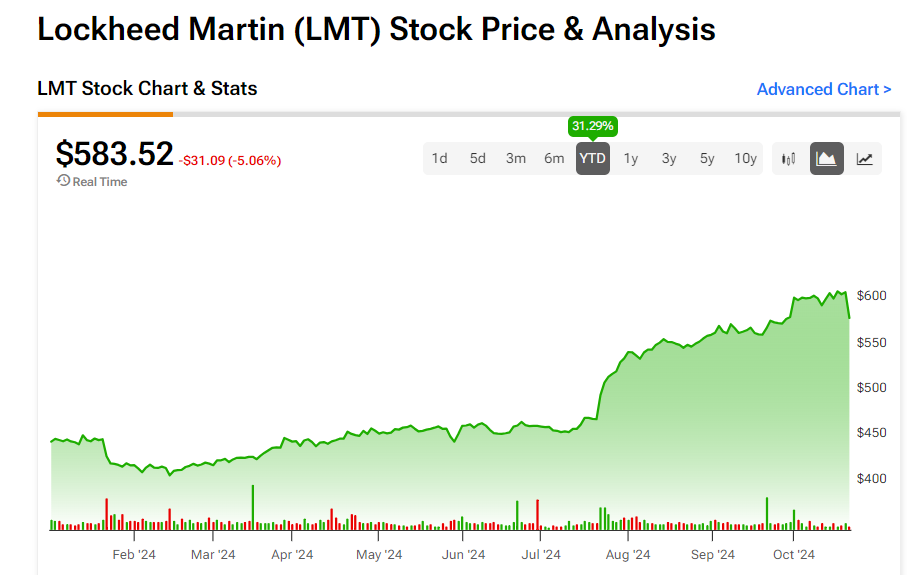Lockheed Martin (LMT) has surged 31% in 2024, outperforming the S&P 500’s (SPX) 23% gains, thanks to increased defense spending as geopolitical tensions continue to rise. With conflicts in Eastern Europe and the Middle East escalating, governments are prioritizing national security and allocating more resources to defense budgets. However, the stock’s rapid rise suggests that the easy gains may already be behind us.
Claim 50% Off TipRanks Premium and Invest with Confidence
- Unlock hedge-fund level data and powerful investing tools designed to help you make smarter, sharper decisions
- Stay ahead of the market with the latest news and analysis so your portfolio is always positioned for maximum potential
While Lockheed Martin remains fundamentally strong, its recent performance indicates that the stock may have limited near-term upside. I believe it’s too late to expect significant further growth and maintain a hold rating.

LMT Reports Strong Third Quarter
When Lockheed Martin shared its third-quarter earnings recently, I thought the results were solid. The company’s net sales increased by 1.3% over the year-ago period to $17.1 billion in the quarter. This was fueled by net sales growth in Lockheed Martin’s Missiles & Fire Control and Rotary & Mission Systems segments for the third quarter. The Rotary & Missile Systems segment’s net sales rose by 6% over the year-ago period to $4.4 billion in the third quarter. This was the result of higher volumes for Radars and its Canadian Surface Combatant warship program, as well as its CH-53K, BlackHawk, and Seahawk helicopters.
Lockheed Martin’s topline growth was somewhat pressured by its Aeronautics and Space segments for the third quarter. It experienced a 3.4% year-over-year decline in net sales to $6.5 billion during the quarter. That was due to the lower volume of F-35 stealth fighter jets from delays in receiving additional funding under the Lots 18-19 contract. The Space segment reported $3.1 billion in net sales in the third quarter. That was down 0.8% over the year-ago period due to lower volumes of its Orion spacecraft for the quarter.
Shifting to the bottom line, Lockheed Martin’s non-GAAP EPS edged 1% higher to $6.84 during the third quarter. A nearly 50 basis point decrease in the company’s non-GAAP net profit margin to 9.5% was neutralized by a 4.6% reduction in the diluted average share count via share repurchases.
LMT’s Future Remains Encouraging
Looking beyond this year, Lockheed Martin appears well-positioned to achieve solid non-GAAP EPS growth over the next few years. The increasing global conflicts mentioned earlier are fueling a rise in defense spending worldwide, which is driving up demand for Lockheed Martin’s products.
This demand has exceeded the company’s ability to deliver, leading to a significant increase in its order backlog, which has grown at an annual rate of 7% since 2021. As of September 30, Lockheed Martin’s backlog reached an all-time high of $166 billion. This is equivalent to more than two years of annual revenue. For these reasons, Lockheed Martin’s non-GAAP EPS is expected to jump by 7% in 2025 to $28.32. Another 6.8% growth in non-GAAP EPS to $30.25 is anticipated in 2026.
Lockheed Martin Is A Defensive Dividend
Lockheed Martin’s 2.1% dividend yield is significantly higher than the roughly 1.3% dividend yield of the S&P 500 index. This higher starting income makes it an interesting dividend stock.
That’s especially the case when considering that the non-GAAP EPS payout ratio for 2024 is expected to be in the high 40% range. Such a payout ratio should give Lockheed Martin the flexibility to hand out dividend raises in line with non-GAAP EPS growth in the years to come.
This is why I anticipate at least mid-single-digit annual dividend growth over the next few years. In my view, that’s not bad for a company that has been hiking its dividend for 21 consecutive years.
The Balance Sheet Is Sturdy
Lockheed Martin’s financial condition is also admirable. As of September 30, the company’s net debt (cash and cash equivalents less current maturities of long-term debt and long-term debt, net) was $16.2 billion.
By comparison, Lockheed Martin’s annualized EBITDA through the first nine months of 2024 was $10.1 billion. This is equivalent to a net debt to EBITDA ratio of just 1.6. That’s enough to warrant an A- credit rating from S&P Global (SPGI) on a stable outlook.
The Valuation May Be Too Rich
Lockheed Martin’s forward P/E ratio of 20.6 is considerably higher than its 10-year normal P/E ratio of 17.7. For a business with a growth profile similar to the high single-digit annual growth of the past, this is a lofty valuation to me.
Do Analysts Think Lockheed Martin Stock Is a Buy?
Turning our attention to Wall Street, analysts have a Moderate Buy consensus for Lockheed Martin stock. This is broken down into nine Buy ratings, six Hold ratings, and one Sell rating. At $626.71, the average 12-month stock price target implies that Lockheed Martin has a 9.74% upside.

Investment Summary
As the world’s largest defense contractor, Lockheed Martin is a qualitative business. The backlog continues to steadily grow, which supports its future growth outlook. Lockheed Martin’s dividend is reliable and the balance sheet suggests that it is a financially solvent business. However, my concern is the excessive valuation, which, coupled with limited near-term upside, leads me to initiate coverage with a Hold rating.
















